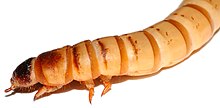Black beetle
| Black beetle | ||||||||||||
|---|---|---|---|---|---|---|---|---|---|---|---|---|

Similar dead beetle ( Blaps lethifera ) |
||||||||||||
| Systematics | ||||||||||||
|
||||||||||||
| Scientific name | ||||||||||||
| Tenebrionidae | ||||||||||||
| Latreille , 1802 |

The black or dark beetles (Tenebrionidae) are a family of the beetles (Coleoptera). With around 20,000 species, they are among the largest families of beetles worldwide. In Europe there are almost 1,800 species and subspecies, in Central Europe there are only around 70 species.
features
The beetles are 1 to 50 millimeters long and are very diverse in their physique. Outwardly, many species resemble representatives from practically all other beetle families. Their body shape ranges from roundish oval to elongated and from flat to spherical. They are usually completely black, black-brown or rusty yellow to brown in color. In many species the body is structured with points. The pronotum is usually as wide as the adjacent part of the wing panels and has a rounded side. Some species have conspicuous structures on them. The wing covers are often structured, in some species they have also grown together at the wing cover seam . In these the second pair of wings has receded. Their antennae have 11 links and are predominantly thread-shaped, but there are also those that are more or less club-shaped at the end. The base (deflection) of the feeler is covered by the cheeks in the form of protruding strips. The long legs of the beetles have five tarsi in front and in the middle , and only four in the back.
A number of species have defensive glands at the end of the abdomen ( pygidial glands ) and some also on the thorax . This allows them to give off foul-smelling defense secretions that are supposed to protect against predators. Also, some sex and aggregation pheromones can secrete.
The larvae have an elongated, round in cross-section, relatively strongly chitinized body and are yellow-brown in color. They look similar to wireworms (larvae of click beetles ).
Occurrence
Black beetles occur in many different biotopes, but they prefer warm habitats. Many species occur in desert and steppe areas , where they are typical inhabitants of sandy areas. Other species live in or on mushrooms , dead wood , sludge, bark, straw, hay, leaves, bird and mammal nests and can also be found as cultural followers in the vicinity of humans in camps, apartments, cellars and stables. Some species live together in society.
Way of life
Most beetles and larvae are herbivores or omnivores . They feed primarily on rotting or rotten parts of plants, but also on seeds, mushrooms, dead insects, etc. Some species are dreaded pests on a wide variety of human supplies. The best- known example of this is the meal beetle ( Tenebrio molitor ). Many species play an ecologically important role in the breakdown of vegetable waste. Most species are crepuscular or nocturnal. During the day they can bury themselves in hot desert sand or walk quickly across the desert floor on their legs with their bodies raised far from the ground.
Systematics (selection)
- Subfamily Alleculinae
- Subfamily Diaperinae
- Subfamily Tenebrioninae
- Glossy black grain mold beetle Alphitobius diaperinus
- Dendarus coarcticollis
- Common dust beetle Opatrum sabulosum
- Opatrum riparium
- Big dead beetle Blaps mortisaga
- Gnaptor spinimanus
- Melanimon tibial
- Menephilus cylindricus
- Nalassus laevioctostriatus
- Flour beetle Tenebrio molitor
- Big rotten wood beetle Uloma culinaris
- Little rotten wood beetle Uloma rufa
- Large black beetle Zophobas morio
- Bolitophagus reticulatus
- Phaleria
- Scaurus
- Subfamily Pimeliinae
- Subfamily Phrenapatinae
- Subfamily wool beetles (Lagriinae)
- Lagria atripes
- Common wool beetle ( Lagria hirta ) (Linnaeus, 1758)
Fossil evidence
The oldest known find of a black beetle comes from the lignite layers of the Geiseltal , which belong to the Middle Eocene . The representatives from at least 10 genera of this family found in Baltic amber are of about the same age . The family is also known from the younger Dominican amber .
Use by humans

Some species, in particular flour beetles , glossy black grain mold beetles , and large black beetles , are bred commercially. They are mainly used in the larval stage as live food rich in protein and fat for pets , as food insects and as bait for sport fishing .
Individual evidence
- ↑ Tenebrionidae. Fauna Europaea, accessed April 25, 2007 .
- ↑ Francesco Vitali: Systematic revision of the fossil cerambycids from Geiseltal (Coleoptera Cerambycidae). In: Entomapeiron Paleoentomology , 3 (1), 2008, pp. 1-16
- ↑ George O. Poinar, Jr .: Life in Amber . 350 pp., 147 figs., 10 plates, Stanford University Press, Stanford (Cal.) 1992. ISBN 0-8047-2001-0
- ↑ Wolfgang Weitschat and Wilfried Wichard: Atlas of plants and animals in Baltic amber , 256 p., Numerous. Fig., Pfeil-Verlag, Munich 1998. ISBN 3-931516-45-8
- ↑ JT Doyen & GO Poinar: Tenebrionidae from Dominican amber (Coleoptera). In: Entomologica Scandinavica , 25, pp. 27-51, Klampenborg 1994; ISSN 0013-8711 .
literature
- Jiři Zahradnik, Irmgard Jung, Dieter Jung et al .: Beetles of Central and Northwestern Europe. Parey, Berlin 1985, ISBN 3-490-27118-1
